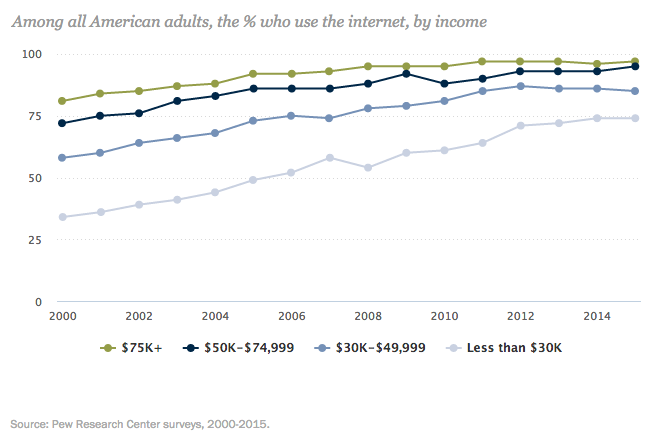White House Unveils New Plan To Get Affordable Broadband Access To Low-Income Households

(Steve)
While most of us don’t have much choice in providers, we do at least have access from someone. But that access is out of reach for millions of households at the lowest levels of income. The latest Census Bureau estimates say that about 25% of the nation still lacks broadband access at home.
So how do you get internet access to more of the nation’s poorest families? The answer is deceptively simple: go where they live.
The White House today announced a new initiative to do just that. The pilot program, ConnectHome, is a partnership with non-profit agencies, local governments, and private business to bring broadband access to public housing around the U.S. The plan is to bring no- or very-low cost broadband into public housing so that low-income families can get online.
It’s not municipal broadband; private companies are, instead, opening up their wires a bit in markets that they already serve. Participating ISPs include CenturyLink, Cox, Sprint, and Google Fiber, among others. The businesses will provide internet access in the range of $0 to $14.95 for eligible families in public housing in 28 pilot areas.
The initial pilot of the program will reach at least 275,000 low-income households (including over 200,000 children) in 27 cities and one tribal nation, including:
- Arkansas: Little Rock
- California: Fresno, Los Angeles
- Colorado: Denver
- Connecticut: Meriden
- District of Columbia
- Florida: Tampa
- Georgia: Albany, Atlanta, and Macon
- Illinois: Rockford
- Louisiana: Baton Rouge, New Orleans
- Maryland: Baltimore
- Massachusetts: Boston, Springfield
- Missouri: Kansas City
- New Jersey: Camden, Newark
- New York: New York City
- North Carolina: Durham
- Ohio: Cleveland
- Oklahoma: Choctaw Nation (tribal lands)
- Pennsylvania: Philadelphia
- Tennessee: Memphis, Nashville
- Texas: San Antonio
- Washington: Seattle
ConnectHome also has a number of tech and internet businesses like Best Buy, Cox Communications, GitHub, and the College Board, providing relevant education and devices to families in the program. Aside from one $50,000 grant from the USDA for getting ConnectHome up and running in the Choctaw Nation, the $70 million price tag is being entirely provided by private business, non-profit organizations, and local entities.
If this initiative sounds familiar, that’s because it has a whole heck of a lot in common with Comcast’s Internet Essentials, which does basically the same thing but is of course limited to Comcast’s service areas. Comcast began the low-cost, low-speed program for low-income families as a condition of its purchase of NBCUniversal in 2011.
In Comcast’s case, households have to meet a very specific and occasionally very challenging set of criteria in order to enroll in Internet Essentials. While ConnectHome is an umbrella program bringing together different ISPs around the nation, each provider will to some degree set its own terms. Google, for example, will be providing free access to “select public housing authority properties” in areas it serves with Fiber, while CenturyLink will provide its Internet Basics service for $9.95 the first year, and $14.95 for four years after that, to HUD households in its coverage area.
ConnectHome is the latest in a series of government initiatives designed to connect more Americans to the 21st century and all its — digital, online, cloud-based, streaming, and otherwise internet-requiring — tools. Last month, the FCC voted to expand its Lifeline program to allow low-income families to apply the $10 subsidy to broadband service instead of phone service if they choose. That dovetails nicely with ConnectHome, which will help provide $10 broadband service to many of those same low-income homes.
While the internet has become more accessible for all households, including the poorest ones, over the course of the 21st century to date, the digital divide is still real and it is still stark.

Internet use consistently remains lowest in the lowest-income households. Source: Pew Internet Project
The lower the income, the lower the likelihood a household has internet access at home. The White House estimates that in the lowest income quintile — the bottom 20% poorest homes in America — two-thirds of households have a computer, but fewer than half have an internet connection to hook it up to. According to HUD, families in public housing are surviving on an average income of about $13,000 per year (well below the federal poverty guideline), which makes the average monthly broadband bill simply too cost-prohibitive.
White House National Economic Council Director Jeff Zients said on a press call, “Americans need world-class internet because so much of the prosperity that we seek and so many of the jobs that we want to create depend on access to the tools of the digital economy.” He added that the program, “Sends a powerful message to every kid in every community … that they deserve a fair shot at success no matter where they’re from,” from the most densely packed inner-city neighborhood to the most remote corners of a rural reservation.
Cable’s major lobbying group, the NCTA, supports the plan, which President Obama will formally unveil at a speech this evening in Oklahoma.
Want more consumer news? Visit our parent organization, Consumer Reports, for the latest on scams, recalls, and other consumer issues.

